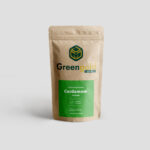Deforestation is a major environmental issue affecting cardamom farming worldwide. Since cardamom thrives in shaded, forested environments, large-scale tree clearing disrupts its growth, yield, and quality. Farmers, businesses, and environmentalists must understand the long-term impact of deforestation on cardamom production and explore sustainable solutions.
1. Why Cardamom Needs Forest Cover? 🌳☀️
Unlike many other crops, cardamom is a shade-loving plant that grows naturally under the dense canopies of forests. The presence of tall trees is crucial for:
✅ Maintaining Soil Moisture 💧 – Forests prevent rapid water evaporation, keeping the soil cool and moist—ideal for cardamom roots.
✅ Regulating Temperature 🌡️ – Cardamom thrives in mild temperatures (10-30°C). Excessive heat exposure due to deforestation can stress plants and reduce yield.
✅ Preventing Soil Erosion 🌎 – Tree roots hold the soil together, reducing erosion from rain and wind—essential in hilly cardamom-growing areas.
✅ Providing Nutrients 🍂 – Falling leaves and organic matter decompose, enriching the soil with natural fertilizers.
When forests are cut down, cardamom plants struggle to survive.
2. How Deforestation Harms Cardamom Farming? ⚠️
🚫 1. Increased Soil Erosion & Nutrient Loss
Without trees, heavy rains wash away the topsoil, which is rich in organic matter. This leads to:
- Poor plant growth due to lack of essential nutrients.
- Exposed roots, making cardamom plants weak and prone to diseases.
🌱 Solution: Use organic mulching and plant cover crops to prevent soil erosion.
🔥 2. Rising Temperatures & Heat Stress
Forests provide natural temperature control. Without tree cover:
- Daytime temperatures rise, leading to wilting and stunted growth.
- Nights become colder, increasing the risk of frost damage in some areas.
🌿 Solution: Maintain shade trees such as silver oak and jackfruit trees to protect crops from direct sunlight.
💦 3. Water Shortage & Drought Conditions
Deforestation reduces rainfall and groundwater levels, leading to:
- Less water availability for irrigation.
- Dried-out soil, making it difficult for cardamom plants to absorb nutrients.
💧 Solution: Implement rainwater harvesting and use drip irrigation for better water management.
🦟 4. Increased Pest & Disease Attacks
Forests support natural predators like birds, frogs, and beneficial insects that control pests. Without trees:
- Thrips, borers, and grubs increase, damaging cardamom plants.
- Fungal diseases like capsule rot spread due to high humidity and soil degradation.
🐞 Solution: Use natural pest control methods like neem oil spray and companion planting.
3. Sustainable Solutions for Cardamom Farmers 🌍🌱
To ensure long-term cardamom cultivation, farmers must adopt sustainable practices:
🌳 1. Agroforestry: Growing Cardamom Under Tree Cover
Instead of clearing forests, grow cardamom alongside shade trees like:
- Silver oak (fast-growing, provides good shade)
- Jackfruit trees (adds biodiversity)
- Pepper vines (adds extra income for farmers)
🌟 Benefit: Protects cardamom plants while preserving the environment.
💦 2. Water Conservation Techniques
Since deforestation affects rainfall, farmers should use:
✅ Rainwater harvesting – Collect rainwater in ponds or tanks for irrigation.
✅ Drip irrigation – Saves 50-70% of water, ensuring moisture reaches cardamom roots.
✅ Mulching – Using dried leaves retains soil moisture longer.
🌱 3. Reforestation & Plantation Regeneration
🌍 Replanting trees is the best long-term solution. Farmers can:
- Participate in afforestation programs to restore lost tree cover.
- Use organic compost to revive degraded soils.
- Join community-led conservation projects.
4. The Bigger Picture: Why It Matters 🌏
Deforestation doesn’t just harm cardamom farmers—it impacts:
🌦️ Climate change – Less forest cover leads to rising global temperatures.
🐦 Biodiversity loss – Many species depend on cardamom forests for survival.
🚜 Sustainable agriculture – Without forests, the future of cardamom farming is at risk.
By promoting eco-friendly practices, farmers can increase yields, improve soil fertility, and protect the planet! 🌿🌎
Final Thoughts 💡
🌳 Forests are essential for high-quality and high-yield cardamom farming. Deforestation leads to poor soil, rising temperatures, water shortages, and pest attacks—all of which hurt cardamom production.
✅ Sustainable farming methods like agroforestry, water conservation, and reforestation can protect cardamom farming for future generations.
🌱 Support eco-friendly cardamom! Shop sustainable, high-quality cardamom now:
🛒 Buy from Greengold Guide!













